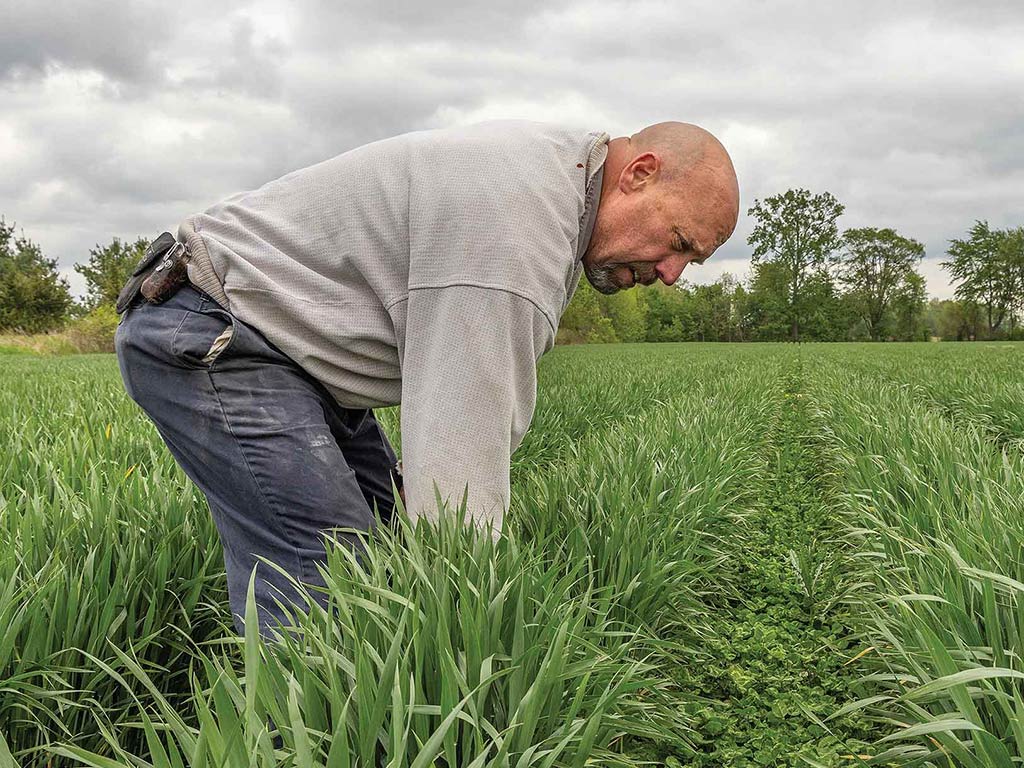Agriculture, Sustainability April 01, 2024
Moving into the Mainstream
Will strip till's time ever come?
by Lorne McClinton
Fifteen years ago, strip till was widely touted as the way row crop farmers could have it all. By just tilling the narrow rows where they will place their seeds, they'll have a strip with higher spring soil temperatures and a trash-free seed bed for planting like conventional tillage methods provide, but still get most of the reduced erosion and increased soil organic matter benefits of no-till.
It was a win-win scenario all around. But despite its large numbers of devoted followers today, it's never quite made it into the mainstream.
There has been a lot of conjecture why this is the case. Some cite the cost of having to buy new specialized equipment, others say that a string of years with wet falls made the extra operation a logistical challenge. Maybe it's just inertia; farmers have grown up with tillage and see little reason to change.
Above. Woody Van Arkel is on a 40-year journey looking to improve the soils on his Dresden, Ont., area farm. He has three goals: disturb the soil as little as possible, keep a cover crop or crop residue and keep a living root system growing.
Tillage increased. "The amount of tillage acres has actually gone up in the immediate area around me," says Woody (Laurent) Van Arkel, a farmer from Dresden, Ont., and Ontario Soils and Crop Improvement Association's 2022 Soil Champion. "I no longer think these technologies will go mainstream unless there is a major disruption; soil depletion alone happens too slowly to do it. It's going to be driven by what I'm going to call society, whether it's government or societal pressure, because of an algae bloom in Lake Erie or some unforeseen thing that's linked to soil erosion or fertility ending up in water wells or waterways."
The lack of farmer interest in strip till is puzzling and a bit discouraging for farmers as passionate about soil improvement as Van Arkel. During his 40-year farming career he's used mulch till, no-till, strip till and has brought in cover crops. He's constantly looking for ways to improve the sandy loam soils on his Dresden, Ont., area farm and stop them from eroding.
"I've three goals: do as little soil disturbance as possible; keep a cover crop or crop residue and keep a living root system growing as much as possible and still be economically feasible," Van Arkel says. "If possible, I'll try to establish cover crops after harvest, too."
His results don't always show up as positive numbers on his balance sheet, but the value shows up in different ways.
Two years ago (2021) was a wet fall, and he helped neighbors harvest, Van Arkel says. One of those he helped out plows extensively and if he would not have had four-wheel drive on his combine, he wouldn't have been able to harvest their wheat. But while his neighbor's field was almost too soft for him to combine, Van Arkel was able to do a strip till operation in his own wheat field, just five miles down the road, without leaving ruts.
"I really like one of Anne Verhallen's (OMAFRA soil management specialist in Ridgetown, Ont.) analogies," Van Arkel says. "She says, 'it's like changing the oil in the engine of your tractor. The day you pour that oil and spend $200 on a filter for that engine doesn't make you a dime. But five years down the road when that engine is still running, it does.' This is the same thing. This is the maintenance program."
He's currently experimenting with inter row mowing to control herbicide resistant weeds. He strip tills and plants into a fall rye cover crop and then after the crop is established he mows between the rows to control the cover crop. The advantages are the rye not only provides good ground cover over the winter months, it's so competitive that it doesn't allow weeds to become easily established between the rows.
"Sometimes I scratch my head and think I could just grow corn, beans, and wheat like everybody else," Van Arkel says. "But I would get bored."
Van Arkel also believes it's critical to do everything possible to limit soil erosion and nutrient loss to show (governments and society) that farmers can be proactive. Because if lots of people in society are screaming to government about phosphate in Lake Erie, they'll step in with regulations and legislation. If that happens he's afraid that they're going to overreact and just make it incredibly onerous and difficult. ‡
Read More

AGRICULTURE, FARM OPERATION
Show 'Em Your Appreciation
Thank your workers when they go the extra mile for you.




